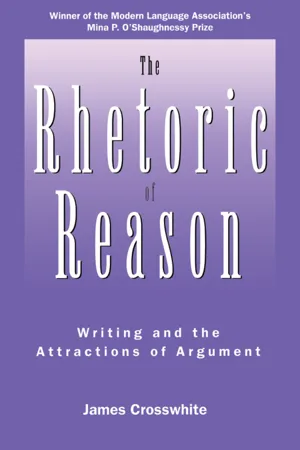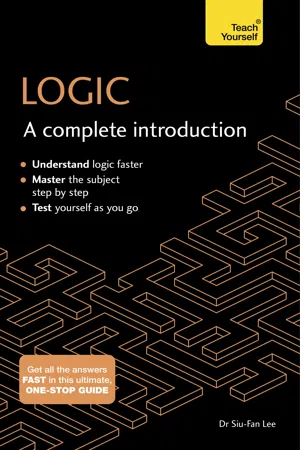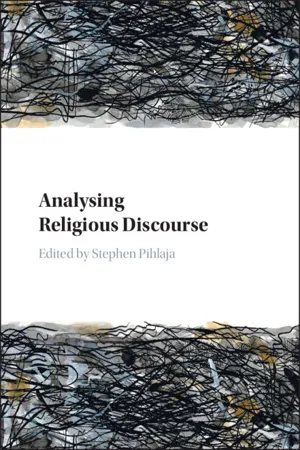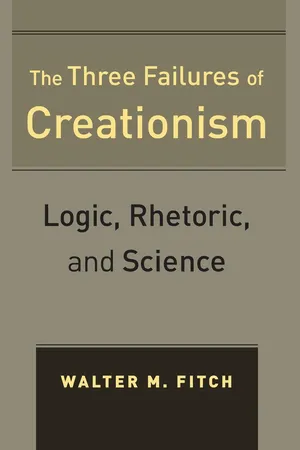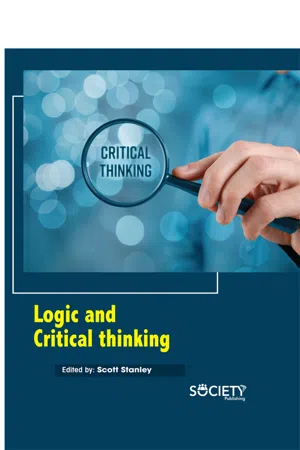Languages & Linguistics
Rhetorical Fallacy
A rhetorical fallacy is an error in reasoning or argumentation that can mislead or deceive an audience. It is a flaw in the logic or structure of an argument that can make it appear more convincing than it actually is. Common examples of rhetorical fallacies include ad hominem attacks, straw man arguments, and appeals to emotion.
Written by Perlego with AI-assistance
Related key terms
1 of 5
6 Key excerpts on "Rhetorical Fallacy"
- eBook - PDF
The Rhetoric of Reason
Writing and the Attractions of Argument
- James R. Crosswhite(Author)
- 2012(Publication Date)
- University of Wisconsin Press(Publisher)
In order for there to be a fallacy, a particular audience must seem to itself capable of judging as a universal audience, and yet be unable to do so. lt must misunderstand its own receptivity to an argument as being more representative than it really is. This explanation of what is fallacious about fallacies provides a way to solve the "basic problem" of fallacy theory. The problem is to find a way to determine in which instances a traditional "fallacy" is reason- able and in which instances it is not. The approach of informal logic has still been to look for formal features or rules of reasoning, or of the di- alogues in which reasoning occurs, in order to distinguish some of these instances from others. A rhetorical approach is quite different. A tradi- tional "fallacy" may be invalid, but still effective and so not unreason- able, when it persuades a particular audience but cannot convince a uni- versal one. Thus, it may be perfectly reasonable to argue "fallaciously" with a particular audience. Clearly, this means that it is not the formal features of the "fallacy" that cause it to be unreasonable. Thus, a rhetoric of reason cannot provide a list of fallacies, or a clas- sification of fallacies, based on the different kinds of logical breaches involved. What it could offer in place of traditional fallacy theory is a classification of different kinds of audience and accounts of the ways in which arguments can go wrong for these audiences, accounts which in- clude descriptions of the types of counterargument that might decrease the effectiveness of specific argument types. In fact, this is exactly what Perelman and Olbrechts-Tyteca have given us in The New Rhetoric. I want to extend their approach to a consideration of some particular classes of fallacy. There are three very general ways arguments can go wrong. First, the essential enabling conditions of argumentation may not be in place. - eBook - PDF
- Timothy Crews Anderson(Author)
- 2021(Publication Date)
- Humanities E-Books(Publisher)
Chapter 4: Rhetorical Devices and Informal Fallacies Not surprisingly, people who wish to convince others to adopt their positions do not always rely solely on attempts to establish sound and cogent arguments. People are often more interested in convincing rather than seeking the truth of the matter. Advertisers, advocates, politicians, political pundits, etc. (the list truly goes on and on) have developed quite an arsenal for levelling arguments or colouring the language of argumentation in such a way as to make the rea-sons for accepting their point of view seem to be much more compelling than they actually are. This need not be intentional; that is, a person’s intent need not be deception to make use of these highly persuasive tactics. Certainly there are many cases in which a devious type will deliberately set out to deceive, but there also many instances in which people in good faith unwittingly make use of them as well. Those who have an interest in identifying attempts at deception as well as those who are interested in compellingly arguing their points in a reason-able manner should take note of what follows. 4.1 Rhetorical Devices A rhetorical device , in general, is a use of language that makes a position seem to be more compelling than it would otherwise be by generating an emotional response . This sort of tactic is especially insidious as it often much easier to manipulate emotions than it is to appeal to reason. Heightened emotions cloud the thinking and often have the effect of masking the fact that emotions have been manipulated in the first place. It is crucial to insightful and critical thought that such manipulation be identified and that a position be dispassionately con -sidered on its merits rather than on emotional responses that have been gener-ated by its proponents or opponents. The following is a brief overview of some rhetorical devices. This list is by no means exhaustive. - eBook - ePub
- Siu-Fan Lee(Author)
- 2017(Publication Date)
- Teach Yourself(Publisher)
3 Informal fallaciesIn this chapter you will learn about:• fallacies from the abuse of language• fallacies of relevance– fallacies of appeal– fallacies about premises and conclusion– fallacious induction‘It’s very good jam,’ said the Queen.‘Well, I don’t want any to-day, at any rate.’ (Alice)‘You couldn’t have it if you did want it,’ the Queen said. ‘The rule is, jam to-morrow and jam yesterday – but never jam to-day.’‘It must come sometimes to “jam to-day,”’ Alice objected.‘No, it can’t,’ said the Queen. ‘It’s jam every other day: to-day isn’t any other day, you know.’Lewis Carroll (1871), Through the Looking Glass, Chapter 5We discussed in Section 2.2 some types of unclear linguistic expressions. Not only does the abuse of language lead to misunderstanding, it can also lead to fallacious reasoning. A fallacy is a type of argument that may seem to be correct but on examination is not so. The fallacies due to misuse of language or irrelevance are usually called informal fallacies, to distinguish them from formal, logical fallacies that form invalid arguments (to be introduced later in Chapters 4 –6 ). There are two main types of informal fallacies: fallacies arising from the abuse of language and fallacies of relevance. Just as there are different types of unclear expressions, there are also different types of fallacies arising from the abuse of language.3.1 Fallacies from the abuse of language EQUIVOCATIONExample (1): Time is money. Time heals all wounds. Therefore, money heals all wounds.The fallacy of equivocation occurs when the same word or phrase is used with two or more meanings, deliberately or accidentally, in the formulation of an argument. This is a fallacy due to ambiguity or vagueness.The word ‘time’ is ambiguous in this example and the speaker employs this ambiguity to make the argument. The argument even looks valid: if ‘is’ means identity and we can substitute identical things with each other, then substituting ‘time’ with ‘money’ in the second sentence give us the words as they appear in the conclusion. However, it is in fact not a valid argument. The reason is that the word ‘time’ has different meanings here, so we just can’t simply replace one token of it with what is predicated of another token. - eBook - PDF
- Stephen Pihlaja(Author)
- 2021(Publication Date)
- Cambridge University Press(Publisher)
Rhetoric has also always been intimately linked to the accumulation and assertion of power and authority and its key concepts intersect and build on one another to make meaning both in the service of, and against the exercise of, political and social power. Rhetoric centres several relationships in its analyses, relationships organised towards persuasion, attempts to get others to align their actions and thoughts with one’ s own. Classically, rhetorical encounters are organised by a ‘triangle’ that includes a rhetor making an argument in a specific situation, all to persuade an audience. Arguments can be complex and made in formal contexts such as courts or in conversation as in Plato’ s dialogues. Rhetoric focuses on 91 how the persuasive appeal of logos (or ‘word’, ‘rationality’) or logical argu- ment central to an exchange, the premises, and the syllogistic constructs are used to make a case. Rhetoric can also be used to track the role of a rhetor’ s ethos (‘nature’, ‘disposition’) or credibility which is crucial to an argument’ s situational effectiveness. Rhetoric’ s final major mode of appeal is the concept of pathos (‘suffering’). Rhetoric highlights how an audience is persuaded not only by the logical structure of an argument, nor simply the credibility of the one making the argument, but also by emotional appeals that ‘move’ them to accept an argument. Emotional appeals are often cast negatively, denigrated as manipulative and subordinate to logic or a very clinical conception of ‘credibility’. But as feminist scholars especially have argued, even a purported ‘lack’ of emotion – the attempt to position emotional appeals as hyper-localised, perhaps frenzied and irrational compared to the calm, cool dispassionate rationality of logic (the former often associated with women and the latter with men) – is itself a rhetorical appeal (Schüssler Fiorenza, 1999). - eBook - PDF
The Three Failures of Creationism
Logic, Rhetoric, and Science
- Walter Fitch(Author)
- 2012(Publication Date)
- University of California Press(Publisher)
Rhetoric, on the other hand, although it considers the meaning of words and logic, is not so much interested in what conclusions are true as in what the persuasive effect of the words and ges-tures may be on you—the reader or listener. The object of rhe-torical material is to convince you of something, whether true or not. (“Buy my product,” “My client is innocent,” “My religion is the only true religion,” etc.) Logic will be considered first, then rhetoric. 6 / Logic, Logical Fallacies, and Rhetoric a. syllogisms The study of logic is quite ancient (Aristotle, 384–322 b.c.), but today logic is dominated by truth tables. A truth table is a set of rows and columns showing true/false values for logical proposi-tions and their components. The true/false values are usually shown, in Boolean algebra style, as “1” for true and “0” for false. Perhaps, for an introduction, it is easier to learn a little about syllogisms. A syllogism is an argument. Any one argument is a collection of three statements (sometimes more) of which the first two statements are called the premises (assumptions or giv-ens; we restrict ourselves to three-statement arguments) and the third statement is the “therefore,” or “conclusion.” The process is of the following form: Premise 1: If Socrates was a man, and, Premise 2: If all men are mortal, Conclusion: Then Socrates was mortal. The first two statements are the assumptions being made, and, if they are true, the conclusion in the third line, correctly formed, must also be valid and true. The three lines can be considered more generally as: Premise 1: A (Socrates) then OR If A is true, then B (man). B is true. Premise 2: If B (man) then If B is true, then C (mortal). C is true. Conclusion: If A (Socrates) then If A is true, then C (mortal). C is true. Logic, Logical Fallacies, and Rhetoric / 7 You will be challenged later to transform an argument into syllogistic form to see if the argument is valid. - eBook - PDF
- Scott Stanley(Author)
- 2020(Publication Date)
- Society Publishing(Publisher)
Informal Fallacies Chapter 6 LEARNING OBJECTIVES The reader should be able to understand the following after the completion of this chapter: ● Understand the meaning of fallacies; ● Learn about the different types of fallacies; ● Recognize fallacies and its types in an argument. Logic and Critical Thinking 150 Key Words: Appeal to force , Bad arguments , Conclusion, Erroneous reasoning, Fallacies, False premise, Logical flaw in arguments, Premise 6.1 THE MEANING OF FALLACIES Fallacy is “a defect in an argument that consists in something other than merely false premises.” It refers to a type of error in reasoning. The structure of such arguments is flawed and does not logically lead to the conclusion. This could be either due to an error in reasoning or a flaw which is present in the argument. Fallacies could be intentional or unintentional. Most of the fallacies involve arguments. Others may include definitions, explanations or other products of reasoning. In the broader sense, the term can also refer to any belief or a cause of a belief. However, most fallacies are those errors which occur while arguing informally. For example, the statement “Blue is not a good color because it is associated with sadness” is an argument. It makes a claim and also provides a supporting reason. The claim could be true or false, however, one might use reasons illogical reasons to support this argument or use an argument in an illogical manner. A person who considers blue as a color that denotes calmness will consider this statement fallacious. Fallacies are an everyday occurrence in the society and many of the times are not committed intentionally. There are certain sections of the society like media, politics, and law where it is more prevalent. Fallacies can camouflage a logical flaw in an argument, hence people who intend to deceive use it to convince the listener or reader of their illogical claims.
Index pages curate the most relevant extracts from our library of academic textbooks. They’ve been created using an in-house natural language model (NLM), each adding context and meaning to key research topics.
